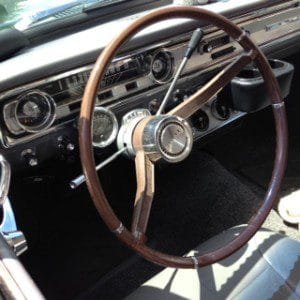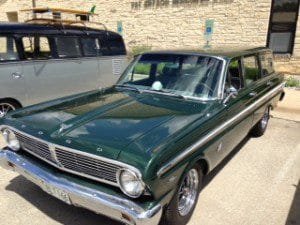The automobile featured in this article is a 1965 Ford Falcon Four Door Station Wagon.

Ford Motor Company produced the Ford Falcon from 1960 to 1970. It should be noted that Ford Motor in Australia did produce the Falcon past 1970.
Ford also produced a two door wagon. Ford made many different types of Falcons. These included sedans, convertibles, Falcon Sprints, the Ranchero, an Econoline Passenger Van and of course the two types of wagons. The top trim level for the 65 Falcon was the Futura series.
The 1965 Falcon’s were of the second generation models. A major redesign took place for the 1964 model year which gave the vehicle a more squared and modern appearance. The Ford Mustang came out in late 1964 and was essentially built on a Falcon frame. Ironically, it was the popular Mustang that pretty much caused the Falcon to disappear in 1970.
When the concept of the Ford Falcon model hit the drawing boards, the goal was to create a good selling economy compact. In fact, compact economy automobiles were important class beginning that year. Styling originally took a back seat. In 1960 the engine was simply a 144 cubic inch six with 90 HP. A V-8 would be introduced to the Falcon in 1963. The Falcon first came out with two- and four-door sedan body styles to be followed shortly after with two- and four-door station wagons along with Rancheros.
Interestingly enough, in 1963 Ford turned to building a few Falcons specially for European Rally’s with the intention of changing the car’s image from stodgy to something more sporty. The result was the Ford did pretty well in Europe during 1963-64 with the Falcon capturing several wins and second place finishes.
The 1965 Falcon Wagon
On the design standpoint, the 1965 Ford Falcon Wagon carried the new more squared design introduced in 1964.
The Ford Falcon Wagon was a good looking automobile and was considered economical to own. The new car base price for the 65 Ford Falcon Wagon was about $2,300. The Falcon Wagon was advertised as giving a smooth and comfortable ride Ford compared the smoothness to a ride in a big sedan.
1965 Ford Falcon Four Door Wagon Specifications
Several engines were available in 1965 for the Falcon wagons. These included two L-head sixes, at 200 cubic inches, and 223 cubic inches with 116 and 138 HP respectively, and a 260 cubic inch V-8 rated at 260 HP.
Transmission choices included a three speed manual or an optional Cruise-O-Matic automatic.
Dimensions included a wheelbase of 109.5 inches, an overall length of 190.0 inches, height of 54.9 inches, width of 71.6 inches. Curb weight varies slightly by two or four door model but the average is about 2,765 lbs.
Total Ford production for the 1965 model year was 2,171,000 vehicles. Out of that number there were 186,000 Falcon model built. Out of that number there were a total of 14,900 Falcon station wagons produced. The majority were four door wagons where only 4,900 two door wagons were made.
 Ford Falcon Station Wagons Collector Valuations
Ford Falcon Station Wagons Collector Valuations
We believe that the Ford Falcon, particularly during the first half of the 1960’s, is an collector car. This is the era prior to and at the time of the Mustang introduction.
Looking at 1965 Falcons as an example, the entire line is relatively inexpensive for someone wanting to start a collection. The highest valued model would likely be the two door convertible with the top prices ranging from about $14,000 to $20,000.
The 65 Falcon Wagon top values are in a range from about $7,000 to $11,000. Both the two and four door wagons fit in this same range.

The Ford Falcon Sprint is a car that had a lot in common with the Mustang and at first was in netter supply at dealers than the Mustang. The Falcon Sprint is a sporty vehicle with power and compares favorably, by some, with the Mustang. Remember, they were building Mustangs on Falcon chassis.
There are many Ford Falcon enthusiasts and an excellent resource for anyone wanting to learn more about the Falcon may want to connect with the Falcon Club of America (www.falconclub.com).
(Article and photos copyright Auto Museum Online)

